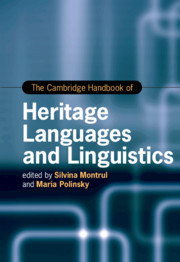Book contents
- The Cambridge Handbook of Heritage Languages and Linguistics
- Cambridge Handbooks In Language And Linguistics
- The Cambridge Handbook of Heritage Languages and Linguistics
- Copyright page
- Dedication
- Contents
- Figures and Tables
- Contributors
- Acknowledgments
- Introduction
- Part I Heritage Languages around the World
- 1 Slavic Heritage Languages around the Globe
- 2 Heritage Languages in Europe
- 3 Heritage Languages in Southeastern Europe
- 4 Heritage Languages in China
- 5 Heritage Languages in Japan and Korea
- 6 Heritage Languages in Israel
- 7 Heritage Languages in Aotearoa New Zealand and Australia
- 8 Heritage Languages in Canada
- 9 Asian Heritage Languages in the United States
- 10 The Vitality of Spanish as a Heritage Language in the United States
- 11 Germanic Heritage Varieties in the Americas
- 12 Arabic in North America
- 13 Heritage Languages in South America
- 14 Language Attrition and Heritage Language Reversal in Returnees
- Part II Research Approaches to Heritage Languages
- Part III Grammatical Aspects of Heritage Languages
- Part IV Heritage Language Education
- Index
- References
4 - Heritage Languages in China
from Part I - Heritage Languages around the World
Published online by Cambridge University Press: 04 November 2021
- The Cambridge Handbook of Heritage Languages and Linguistics
- Cambridge Handbooks In Language And Linguistics
- The Cambridge Handbook of Heritage Languages and Linguistics
- Copyright page
- Dedication
- Contents
- Figures and Tables
- Contributors
- Acknowledgments
- Introduction
- Part I Heritage Languages around the World
- 1 Slavic Heritage Languages around the Globe
- 2 Heritage Languages in Europe
- 3 Heritage Languages in Southeastern Europe
- 4 Heritage Languages in China
- 5 Heritage Languages in Japan and Korea
- 6 Heritage Languages in Israel
- 7 Heritage Languages in Aotearoa New Zealand and Australia
- 8 Heritage Languages in Canada
- 9 Asian Heritage Languages in the United States
- 10 The Vitality of Spanish as a Heritage Language in the United States
- 11 Germanic Heritage Varieties in the Americas
- 12 Arabic in North America
- 13 Heritage Languages in South America
- 14 Language Attrition and Heritage Language Reversal in Returnees
- Part II Research Approaches to Heritage Languages
- Part III Grammatical Aspects of Heritage Languages
- Part IV Heritage Language Education
- Index
- References
Summary
China is one of the most multilingual countries in the world. The government of the People’s Republic of China promotes the country as a harmonious and unified nation with 56 distinct ethnic groups who speak more than 400 heritage languages. The government has not only legally recognized multilingualism but also publicly encouraged a climate where the teaching and learning of a variety of heritage languages can flourish. This chapter provides insights into our understanding of Chinese language policy and implementation and heritage language maintenance and is based on empirical research and case studies in China’s multilingual regions and provinces. It examines the application of the Chinese government’s language policy and heritage language practices over the last 30 years with its underlying language ideology and practices, revealing de facto language policies. While modern standard Chinese (Putonghua) continues to be a powerful factor in both consolidating and probing educational, cultural, social, and political discourse as well as the spatial environment, Xi Jinping’s recent “One Belt and One Road” project has created a new linguistic environment, which has affected the use of heritage languages within diverse minority groups. This has accelerated the deep concern shared among those advocating heritage language maintenance in China.
Keywords
- Type
- Chapter
- Information
- The Cambridge Handbook of Heritage Languages and Linguistics , pp. 91 - 110Publisher: Cambridge University PressPrint publication year: 2021

